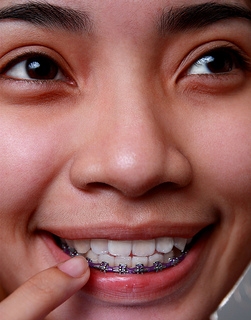February 3rd, 2021

Today, we thought we would offer a few tips for our patients currently undergoing orthodontic treatment. For those of you wearing braces, it’s important to be even more dedicated to good oral hygiene than those not currently in treatment.
After getting your braces, it is important to know how to take care of your teeth in order to ensure that your braces stay intact and do their job so that your teeth are in top-notch condition after you complete your orthodontic treatment.
Braces are known to trap food, which contributes to plaque formation. If it is not carefully removed from the teeth and gums, plaque will develop into decay or gum disease, leading to costly delays during your treatment. It is important to practice good oral hygiene by following instructions your treatment.
We are proud to offer supplies to help fight plaque, such as a proxabrush, dental floss, and floss threaders. The use of an electric toothbrush and or a water pick can also be helpful in combating cavities and decay. And, of course, our team at Spring Valley Orthodontics suggests brushing at least twice a day.
We hope that helps! If you have any questions, please give us a call or ask us during your next adjustment appointment!
January 27th, 2021

Did you know that even in ancient times, people wanted to improve the look and function of their smiles? Spring Valley Orthodontics thinks of modern orthodontic appliances as sleek, efficient technology, but this was not always so! Take a look at the highlights in the evolution of braces.
Ancient Times: From Greece to Rome
- According to The Angle Orthodontist, Aristotle and Hippocrates first thought about methods for straightening teeth between 400 and 300 BC.
- The Etruscans, in what we now know as Italy, buried their dead with appliances that maintained spaces and prevented collapse of their teeth and jaws during life. Archaeologists have discovered mummified remains in various locations that have metal bands wrapped around the teeth.
- A Roman tomb has also been discovered in which the teeth were bound with gold wire, including documentation on the wire’s use as a dental device.
18th Century: A French Development
- The French dentist Pierre Fauchard is acknowledged as the father of modern dentistry. In 1728 he published a book that described various methods for straightening teeth. Fauchard also used a device known as a “blandeau” to widen the upper palate.
- Louis Bourdet was another French dentist who published a book in 1754 that discussed tooth alignment. Bourdet further refined the blandeau and was the first dentist to extract bicuspids, or the premolar teeth between canines and molars, for the purpose of reducing tooth crowding.
19th Century: Orthodontics Defined
- Orthodontics started to become a separate dental specialty during the early 19th century. The first wire crib was used in 1819, marking the beginning of modern orthodontics.
- During this period, gold, platinum, silver, steel, gum rubber, vulcanite, and occasionally wood, ivory, zinc, and copper were used — as was brass in the form of loops, hooks, spurs, and ligatures.
- Edward Maynard first used gum elastics in 1843 and E. J. Tucker began making rubber bands for braces in 1850.
- Norman W. Kingsley published the first paper on modern orthodontics in 1858 and J. N. Farrar was the first dentist to recommend the use of force over timed intervals to straighten teeth.
20th Century: New Materials Abound
- Edward Angle developed the first classification systems for malocclusions (misaligned teeth) during the early 20th century in the United States, and it is still in use today. Angle founded the American Society of Orthodontia in 1901, which was renamed the American Association of Orthodontists in the 1930s.
- By the 1960s, gold was universally abandoned in favor of stainless steel.
- Lingual braces were the “invisible” braces of choice until the early 1980s, when tooth-colored aesthetic brackets made from single-crystal sapphire and ceramics became popular
Today
As we arrive in the present, you need only look at your own braces to see how far we’ve come. Your treatment plan was probably created with a 3D digital model, and we’ve likely used a computerized process to customize your archwires. Perhaps you have clear aligners, self-ligating brackets, or highly resilient ceramic brackets with heat-activated wires.
Orthodontics has come a long way from the days of Aristotle, and even the bulky wrap-around braces of just 60 years ago. Regardless of your specific treatment plan, the development of high-tech materials and methods has made it possible for your orthodontic experience to be as effective, efficient, and comfortable as possible. Call our office to schedule your first orthodontic consultation!
January 26th, 2021
Happy 2021 from Bethesda and Spring Valley Orthodontics! As the new year begins, I’ve set some new professional and personal goals for the months to come.
In the office, I’d like to expand the number of patients she sees who are using the game-changing technology that is BRIUS. Treatment using BRIUS is completed much faster than traditional braces and aligners. If you are looking for more information regarding BRIUS please follow this link to learn more about the advantages about choosing this treatment option.
At home, it’s all about finding balance. It can be so difficult, especially in a COVID world! And it might be even harder when we are able to do more again. We all need to remember to take time to recharge and focus on what is meaningful. For me, that means more yoga, stretching, and meditation. We can’t forget to take time to connect with ourselves in a fast-paced world.
I also plan to continue learning, mostly through academic journals. I’ve love to take advantage of all the Washington, D.C. area has to offer in terms of art and history. Once it’s safe to get out more, of course!
With the COVID-19 vaccine starting to become available to healthcare workers and the elderly, and soon the public at large, there is so much promise on the horizon for us all. I can’t wait to take the COVID vaccine! I also forward to seeing my patients smile without a mask.
Regardless of what your resolutions are for the year, I hope you will recommit (or continue to stay committed) to your oral hygiene. Remember three simple words for you: floss, floss, floss!
January brings us in welcome change and newness. Have a phenomenal start to the year and I can’t wait to see you in the office!
January 20th, 2021

When a child is born, he or she will have 20 primary teeth and 32 permanent teeth. But sometimes kids are born with additional teeth, and our team at Spring Valley Orthodontics calls this oral condition "hyperdontia." Primary teeth are the first set of teeth that erupt in your child's mouth, typically by the time they are 36 months old, and are shed by the time your child reaches the age of 12. Permanent teeth then take the place of the primary teeth and are usually fully-erupted by the time your son or daughter reaches 21 years of age. Anyone who develops more than 20 primary teeth or more than 32 permanent teeth has hyperdontia, and the additional teeth are referred to as supernumerary teeth.
While the cause of hyperdontia is not entirely clear, it is believed that there may be a genetic factor. Oral professionals have found that patients with extra teeth often have syndromes like cleidocranial dysplasia, Ehler-Danlos syndrome, Gardner syndrome, or cleft lip and palate. The prevalence of hyperdontia affects between one and four percent of the population in the United States, and the majority of cases are limited to a single tooth.
So, what is the best way to deal with hyperdontia? It really depends on the case. The treatment plan your doctor suggests varies according to the potential problem posed by the supernumerary teeth, as well as their type. Orthodontic treatment may certainly may help, but extraction can also be a good option. We recommend that children receive an oral evaluation or checkup no later than the age of seven. In addition to hygiene evaluation, this helps ensure your child does not experience hyperdontia problems.
If you suspect you or your child may be suffering from hyperdontia, please give us a call to schedule an appointment at our convenient Washington D.C. office to be evaluated.










